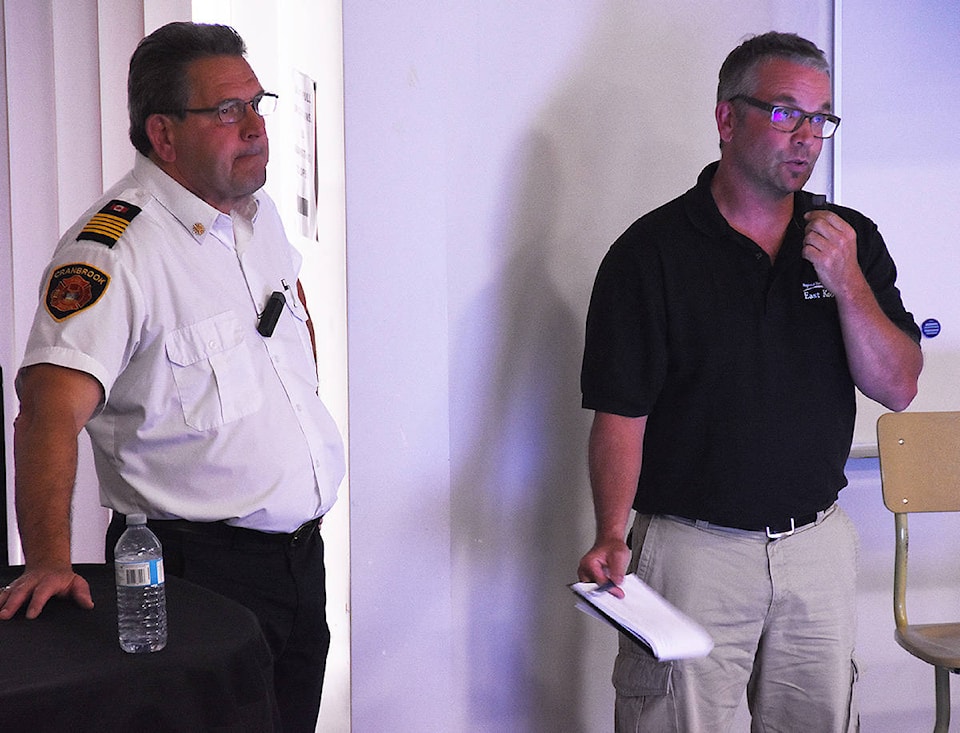An American academic researcher gave a two-hour presentation on the emergence of mega wildfires over the last 30 years and the contributing factors to the phenomenon up at the College of the Rockies.
Dr. Paul Hessburg spoke about the dangers of mega wildfires and what people and governments can do to mitigate large-scale fire events, such as what happened in Fort McMurray last year, or what is currently occurring in the BC Interior.
Following his presentation, there was a Q&A with local fire officials that included representation from the City of Cranbrook, the Regional District of East Kootenay and the Southeast Fire Centre.
Wildfire threats aren’t a new phenomenon, but it wasn’t until 2003 that the city received a ‘wake-up’ call when wildfires ripped through the Okanagan, according to Wayne Price, the Director of Cranbrook Fire and Emergency Services.
Since then, the city has partnered with the Regional District of East Kootenay to work together through an emergency management system.
“The City of Cranbrook did not have the ability to staff an EOC (Emergency Operations Centre) for a major operations for a long duration or a large scale event,” Price said. “We don’t have the resources available and and it’s big dollars, big overhead.
“In turn, the RDEK did not have the resources, infrastructure to support a large-scale incident in their area for a long duration, so we got together and we have a joint emergency program now. Kimberley is involved, all the East Kootenay is involved, so we all work under the regional district emergency plan.”
Travis Abbey, the Emergency Services Coordinator for the RDEK, said that resources are spread thin, however, the RDEK does try to coordinate with member municipalities to tackle wildland urban interface treatments.
In 2012, the regional district created a plan that identified over 100 priority areas for treatment, but progress has been slow.
“I’m on my second one since I started [at the RDEK] in 2015 and there are a couple others that were done before that,” said Abbey. “Not to say there isn’t a bunch of other great work going on from the forest districts and the Cranbrook work and some of the other communities as well with areas that are outside the municipalities and abut regional district jurisdiction so theres some sharing of the efforts there too.
“But I’m not going to lie to you. It’s slow. It’s cumbersome.”
As far as the danger goes to Cranbrook, there is a daunting figure in front of local officials, said Price.
“Everybody go stand up on a hill and look around the City of Cranbrook,” he said. “To truly protect the City of Cranbrook, we’re probably looking at 50,000 hectares that need to be treated. When you look between $5,000-7,000 a hectare, depending on the area you are in to do a prescription in, that’s pretty big dollars.”
However, there are plans in the works to tackle that, Price added.
He alluded to the work that Mayor Lee Pratt and council have done to work with the Ministry of Forests, Lands and Natural Resource Operations for a pilot project that would essentially allow forestry companies to log what they can out of treatment areas to generate some economic benefits.
Mike Morrow, a fuels management specialist with the Southeast Fire Centre, said that there is a plan in place to put in a fuel break at the south end of Cranbrook in Gold Creek.
“This past winter we had Canfor in there and they did approximately 60 hectares of treatment,” Morrow said. “As soon as the ground is right, they’re going to go in there and finish it and probably end up doing 300 hectares. The east side of the treatment, Canfor is going to be going up into the South Star ski trails and doing another 300 hectares.
“…It’s not all doom and gloom. We are moving ahead. We figure the whole project is approxmiately 3000 hectares. I’m hoping it will be done within the next two or three years. Once it’s done in two to three years, we’re going to tackle a different side of Cranbrook, we may go on the west side up Jim Smith Lake/Fassiferne area or potentially the Community Forest.”
While selective logging is one tool in the toolbox to mitigate wildfire risk, Morrow also highlighted the benefits of prescribed burning. Going into an area to log by hand can cost up to $7,000 a hectare, while costs for a prescribed burn is only $70 a hectare. Locally there have been prescribed burns in the past out at Elko, Fort Steele, Wildhorse drainage and Kimberley Nature Park.
“So if we can get Canfor on board, BC Timber Sales on board, go in there and harvest a merchantable volume, make money so we’re not losing money doing it — they’re doing the heavy lifting for us, we go in later, we do the prescribed burn, our costs go way down,” Morrow said. “With less cost, we cover more ground with the limited lobby money we get.”
While local and provincial governments are taking a hand in wildfire prevention, all the officials noted that homeowners have a part to play in prevention as well. Visit www.firesmartcanada.ca for more information on how to protect your home and your neighbourhood.
